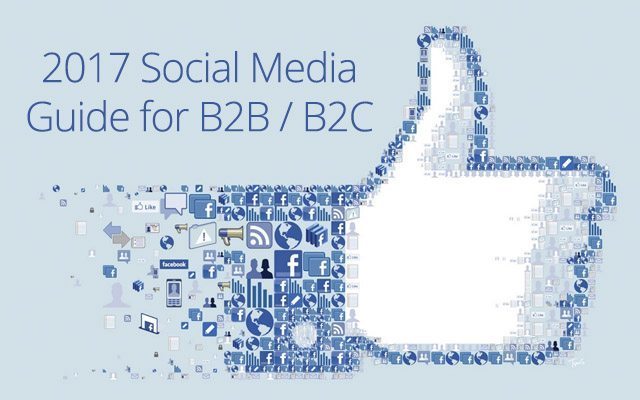Optimizing your business pages on social media should be an important part of your marketing strategy. Social media optimization techniques are inexpensive and help you rake in quality customers. Most importantly, it helps you build long-term relationships with your customers.
You must remember the main aim of Social Media Marketing – creating long-lasting relationships.
If you optimize your social media profiles with business profits in mind, you might be in for some disappointment. Hence, be careful when creating a social media strategy for your business. And while you are at it, here is a go-to guide on how you can optimize your social media business pages for Facebook, Twitter, LinkedIn and Instagram.
Let’s start with the optimization basics.

1) Use Your Logo as Your Profile Picture/Avatar Consistently
On social networks, people are not interacting with you: they are there to interact with your brand. If you want people to recognize you on all fronts, then the best practice is to set your official logo (or a variation of it) as your profile picture. Just make sure your avatars remain consistent throughout your social media presence. Here is a quick avatar image size guide for different social media platforms:
- Facebook: 180×180 px
- LinkedIn: 400×400 px
- Twitter: 400×400 px
- Pinterest: 165×165 px
- Instagram: 110×110 px
- Google+: 250×250 pxI would recommend you to check out this infographic cheat sheet for Social Media Image Optimization.
2) Use the Company’s Name as the Username
One of the most authentic ways of creating a great relationship with customers on social media platforms is through mentions. When users mention you on social media, they usually look up the names that seem the most logical. In the case of businesses, it is usually the brand name. It is usually a difficult task to score your brand name as the username, especially if the brand name is a common word or phrase.
Having a consistent identity makes the social media presence very search engine friendly and allows the users to find the brand with ease. Even if you are not able get your desired username, you can always go for some suitable variations, but make sure your username isn’t any different than your brand identity.
3) Time Your Posts Appropriately
As the saying goes, you shouldn’t put all your eggs in the same basket. Likewise, every social media channel is different, each with different demands and optimal timings for content updates. You need to balance both the industry (B2B or B2C) you are in and the class of consumers you are catering to.
For example, for B2B customers, it is essential to update Facebook 5-10 times per week. Whereas for B2C audience, the frequency can go as high as 20 posts per week. Every social network is different and caters to a different group of users. Therefore, the update frequency needs to be in sync with the social network you are on.
Here is a great infographic from Hubspot to help you get started. However, it is a good practice to schedule your posts according to your social analytics. See this post from HBO as an example. In this example, HBO is promoting a movie, A Million Ways to Die in the West, with a “Starts Now” call to action. This gives followers the right idea of what they are supposed to do with the post.
4) Give Proper Shout Outs
You are on social media because you want to interact with people. You are there to create relationships with your audience, and the best way to create strong relationships on social media is to give credit, wherever it is due.
For example, when you are sharing content created by someone else, be sure to give them proper shout-out by adopting a simple “Via – [Name of the User]”. This adds to the authenticity of your social media presence and helps you rank higher as well. See the example from Oreo. Orea craftily uses March Madness, the NCAA’s Basketball tournament by tagging Alex Trochut to promote their own playwithoreo.com.

5) Shortened Links with Tracking Tokens
Shortened links help you track your content updates. They are trackable links that let you know which updates are driving the most traffic, and which pieces you should consider re-marketing. You can look at the image below as to how it can be used to put more words in your tweets. Those small links can help you take your page to greater heights. Shortened links allow you to describe more in less words by giving you more space. Use them wisely.
6) Focus on Visual Content with High Quality Images
Have a look at the image below. Scrumptious, right?
But only if it is in high quality. Yes, it is incredibly important to use high-quality images for your social media posts as search engines really dig these images. There are a lot of online resources that can help you create high-quality images without requiring you to be an expert in Photoshop. One such tool is Canva.com, which lets you create awesome pictures for your social media.
7) Be Actively Social
But only if it is in high quality. Yes, it is incredibly important to use high-quality images for your social media posts as search engines really dig these images. There are a lot of online resources that can help you create high-quality images without requiring you to be an expert in Photoshop. One such tool is Canva.com, which lets you create awesome pictures for your social media.
7) Be Actively Social
Social media is… well, for socializing. It is not only a medium for you to share your content, but a medium for you to interact with your audience. You should respond to users that reach out to you, as they expect you to be socially active and serve the purpose of the platforms. A good tool to monitor this is Community. This is very important especially in case of complaints or queries, where the expectation level of users are very high.
8) Pay Close Attention to your “About Us” Page
Your visitors want to know every little detail about you. They expect to get details such as office location, services offered, working hours and so on from your social media pages. You should therefore use your About Us section strategically, and offer as much information as possible.
About Us section is similar to a Meta Description of your web-page, as you need only a short description [about 155 characters] in order to display the information correctly on search engines. For example, look at this About Page from Cloudways, a Managed Cloud Hosting provider. It has everything required with the right details in place.
2017 B2B / B2C Social Media Guide Conclusion
There is no doubt that the the most important objective of Social Media is to engage audience and produce valuable content for them. Therefore, once you are on social media and looking to optimize your B2B channels, tailor your posts according to your target audience, be personable with them, and most importantly, try to be as simple as you can be when communicating with them.

Ahmed Khan is the PHP Community Manager at Cloudways, a hosting company that specializes in optimized PHP hosting services. He writes about PHP, MySQL and covers different tips and tricks related to PHP. You can follow him on Twitter or connect with him on Facebook.
Click here to view original web page at justcreative.com



